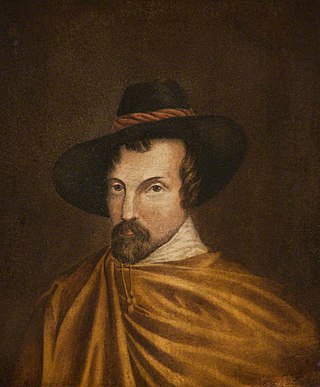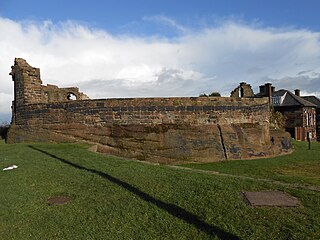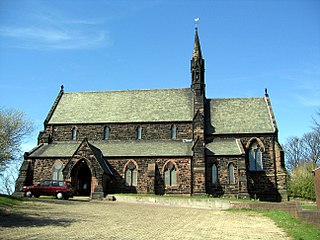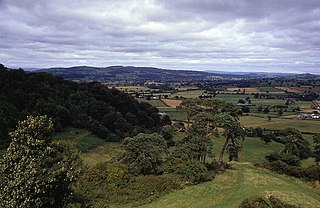Sir Henry Brooke, 1st Baronet (died 1664) was an English soldier and politician.

Sir Henry Brooke, 1st Baronet (died 1664) was an English soldier and politician.

Brooke was a great-grandson of Richard Brooke, who purchased Norton Priory from Henry VIII in 1545. His father was Sir Richard Brooke of Norton (died 10 April 1632) and his mother was Catherine Neville (the daughter of Sir Henry Neville of Billingbear). [2]
At the outbreak of the Civil War, Henry Brooke declared his support for Parliament in 1642 by signing the Cheshire Remonstrance. In so doing, he became the only major Parliamentary supporter in the northwest of the Bucklow Hundred. [3] In 1643 he was appointed a colonel in the parliamentary army and in 1644 he was made High Sheriff of Cheshire, a post he held for four years. [4]
By early 1643 most of Brooke's immediate neighbours were powerful Royalists, in particular John Savage, 2nd Earl Rivers of Rocksavage and Sir Thomas Aston of Aston. Further afield the Royalist leader of Lancashire was James Stanley, 7th Earl of Derby. Brooke's house, Norton Priory had been well prepared for an attack. On 28 February 1643, Royalist forces arrived at Norton Priory. Despite being heavily outnumbered, their attack was repelled and the Royalists withdrew to Halton Castle. Norton Priory then provided a base from which to mount a successful attack on Warrington in May. The following month Sir Henry's forces besieged Halton Castle which was surrendered after three weeks. Norton Priory was not threatened again during the Civil War. [3]
Following the Civil War, Henry purchased the Manor and Castle of Halton. He became magistrate at Farnworth and was elected as a Member of Parliament for Cheshire. In 1659 he joined others of the Presbyterian gentry to support George Booth in restoring the monarchy. He was imprisoned in Chester Castle but with the coming of the Restoration he was released and made the 1st Baronet of Norton Priory by Charles II in 1662. [3]
Brooke married Mary, the daughter of Timothy Pusey of Selston, Nottingham. He was succeeded by his eldest son, Richard. [4]

Sir William Brereton, 1st Baronet, 13 September 1604 – 7 April 1661, was an English religious Independent, author, and landowner from Cheshire. He was Member of Parliament for Cheshire at various times between 1628 and 1653, and during the First English Civil War, commander of Parliamentarian forces in the North Midlands.

Beeston Castle is a former Royal castle in Beeston, Cheshire, England, perched on a rocky sandstone crag 350 feet (107 m) above the Cheshire Plain. It was built in the 1220s by Ranulf de Blondeville, 6th Earl of Chester (1170–1232), on his return from the Crusades. In 1237, Henry III took over the ownership of Beeston, and it was kept in good repair until the 16th century, when it was considered to be of no further military use, although it was pressed into service again in 1643, during the English Civil War. The castle was slighted in 1646, in accordance with Cromwell's destruction order, to prevent its further use as a bastion. During the 18th century, parts of the site were used as a quarry.
The First Battle of Middlewich took place on 13 March 1643, during the First English Civil War, and was fought between the Parliamentarians, under Sir William Brereton, and the Royalist supporters of King Charles I of England, under Sir Thomas Aston.
The Bunbury Agreement of December 23, 1642 was a declaration of neutrality drawn up by some prominent gentlemen of the county of Cheshire shortly after the outbreak of the First English Civil War. Like similar attempts in Lancashire and other counties, it was ignored by both Parliament and Charles I, since the strategic importance of Cheshire and the city port of Chester meant national interests overruled local ones.

The Barony of Halton, in Cheshire, England, comprised a succession of 15 barons and hereditary Constables of Chester under the overlordship of the Earl of Chester. It was not an English feudal barony granted by the king but a separate class of barony within the County Palatine of Chester.

Halton Castle is a castle in the village of Halton, part of the town of Runcorn, Cheshire, England. The castle is on the top of Halton Hill, a sandstone prominence overlooking the village. The original building, a motte-and-bailey castle began in 1071, was replaced with the current sandstone castle in the 13th century. Building alterations continued until at least 1609, when the structure is recorded as in disrepair. The castle is recorded in the National Heritage List for England as a designated Grade I listed building, and a scheduled ancient monument.

Sir Thomas Aston, 1st Baronet was an English politician who sat in the House of Commons in 1640. He fought for the Royalist cause in the English Civil War. The portrait he commissioned from John Souch of his first wife Magdalene Aston on her deathbed is in Manchester Art Gallery. He is known as an apologist for the Church of England.
There have been six baronetcies created for persons with the surname Brooke, one in the Baronetage of England, one in the Baronetage of Ireland and four in the Baronetage of the United Kingdom. As of 2015 four of the creations are extant, though one has been subsumed into a peerage.

Richard Brooke or Broke was an English landowner and navy officer.
Events from the year 1643 in England. This is the second year of the First English Civil War, fought between Roundheads (Parliamentarians) and Cavaliers.

St Mary's Church is in Halton, which was formerly a separate village, but is now part of the town of Runcorn, Cheshire, England. It is an active Anglican parish church in the diocese of Chester, the archdeaconry of Chester and the deanery of Frodsham. The church is recorded in the National Heritage List for England as a designated Grade II listed building.

John Savage, 2nd Earl Rivers was a wealthy English nobleman, politician and Royalist from Cheshire.

Sir Richard Grosvenor, 2nd Baronet was an ancestor of the modern day Dukes of Westminster. He was the son of Sir Richard Grosvenor, 1st Baronet and Lettice Cholmondeley, daughter of Sir Hugh Cholmondeley. He spent his childhood at Eaton Hall, Cheshire.
The timeline of Cheshire history shows significant events in the history of the English county of Cheshire.

Sir William Savile, 3rd Baronet of Thornhill was an English politician who sat in the House of Commons between 1640 and 1642. He fought on the Royalist side in the English Civil War and was killed in action.

Sir Gilbert Hoghton, 2nd Baronet was an English politician who sat in the House of Commons variously between 1614 and 1640. He was a Royalist leader during the English Civil War.
This is a timeline for the English Civil War in Shropshire.

The Battle of Montgomery took place during the First English Civil War of 1642–1646. On 17 September 1644, a Parliamentarian force commanded by Sir John Meldrum advanced to engage a Royalist army led by Lord Byron which was besieging Montgomery Castle in mid Wales. The battle was fought the next day. After the Royalists gained an initial advantage, the Parliamentarians counter-attacked and destroyed Byron's army.
Edward Bridgeman was an English politician who sat in the House of Commons between 1625 and 1629.

The Constable of Chester was a mediaeval hereditary office held by the Barons of Halton. The functions of the Constable are unclear, possibly they related to the custody of Chester Castle, as was the main function of most mediaeval constables, but Sanders (1960) says the office-holder was constable for the entire County Palatine.